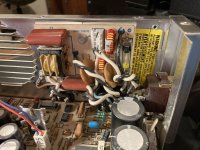For clarity - when the red switch was turned on, the 15A breaker for the room, out at the breaker box, was tripping. I relocated to a protected outlet in the bathroom, so it would trip instead of out at the house panel.
Now for the good, but confusing news. I had the power supply out and open and blew out dust and some little bits I heard floating around. Took the power supply by itself, plugged it in, turned on the red switch, and the fan started and the outlet didn't trip. Next I put the power supply back in the unit and connected all of the connectors. Then turned it on and, again, all worked fine, no trip. Next I hooked up the monitor, tried again, and no trip. Finally, I attached the keyboard and put in the startup disk - and it all started up and worked fine.
So, sorry for all of this, but it appears to be working now. Not sure what happened. I guess I will make sure that everything is cleaned out, no bits floating around, and put it all back together.
Any other ideas? Thank you all again!


